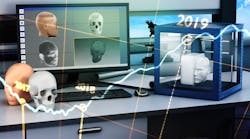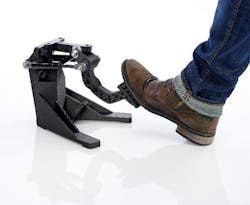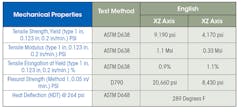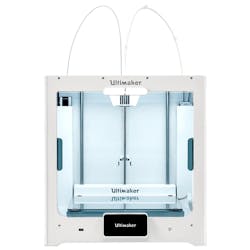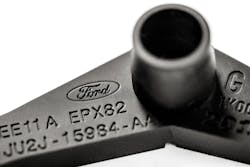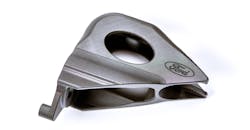In Part 1, I wrote about the 3D printing market predictions, standards, inspection, technology and materials that might expand and thrive in 2019. This article will focus on companies that are making it happen: How Stratasys is pushing for carbon fiber tooling, Ford and Carbon’s work on the F-150 Raptor Auxiliary Plugs, Ultimaker’s expanded push into industrial printing, and Optomec acquiring Huffman to accel the company into the repair and aftermarket.
Stratasys and 3D Printed Tooling
Using 3D printing indirectly can be a great way the process can accelerate production. Often people think of printing parts, but printing jigs, fixtures, and even molds have shown a lot of value in the industrial markets. 3D-printed composite tooling technology such as FDM offers a fast, cost-effective means of producing composite structures. FDM composite tools take only days to produce instead of weeks or months and avoid the high cost, touch-labor, and long lead times of traditional tool fabrication.
Users can print plastic molds for layup, print a tool directly, or take advantage of the FDM’s dissolvable support materials to simplify the production of hollow and trapped-tool configurations. The tool material dissolves in a detergent solution, leaving only the cured composite part and enabling one-piece, seamless designs. This was demonstrated at JEC World, in Paris Nord - Villepinte, on March 12-14 by Stratasys as it showcased its latest 3D printing advancements for composite production: high-performance, cost-efficient 3D printed tools.
Engineers are seeing how FDM Nylon 12CF can replace traditional metal parts with 3D-printed plastic composites. This carbon fiber-filled thermoplastic contains 35% chopped carbon-fiber and with tensile strength over 9 kips it is strong enough to replace metal. The high stiffness-to-weight ratio of FDM Nylon 12CF is ideal for functional performance testing demands in automotive, aerospace, recreational goods, and industrial manufacturing sectors.
Ultimaker in an Industrial Environment
Ultimaker is often categorized as a hobbiest printer. However, like Stratasys, industry are using the printers for tooling, fixtures, and ergonomics. One example of desktop 3D printing being used at scale today can be found at Volkswagen Autoeuropa, a VW plant in Portugal that produces 100,000 cars per year and specializes in engineering innovations and new models.
Using a group of desktop 3D printers, the VW manufacturing plant produced 1,000 tools last in 2016—including gauges, jigs, and fixtures. Printing on-demand in the plant, as opposed to outsourcing, reduced tool development by 95%, and saved 90% in production costs.
Recently, Ultimaker’s portfolio was selected by Airbus for 3D printing in Europe. The market for 3D printing technology and materials in aerospace is expected to increase to $531.1M by 2024, according to Frost & Sullivan. From manufacturing aids and prototypes to end-use parts, desktop 3D printers are enabling organizations like Airbus and Royal Netherlands Airforce to innovate on the fly while preparing the workforce for tomorrow (regardless of technical acumen).
The S5 released in 2018 offers a bigger build area and other features that show Ultimaker is aiming to move into more industrial applications.
Airbus will mainly use the Ultimaker portfolio for the direct, local production of tools, jigs, and fixtures, and printing lightweight design parts with composite materials. But why not a large more expensive that might offer more features?
Ultimaker was selected by Airbus because of its ease of use, reliable results, and open technology, which meets the stringent requirements the aerospace industry. In addition, Ultimaker’s open source software Cura works so well some competing printer manufactures use it to run their printer.
According to a recent Frost & Sullivan report, the global 3D printing materials market for the aerospace industry is expected to reach $535.1 million by 2024. Airbus has historically embraced 3D printing, and the partnership with Ultimaker further underscores their commitment to further utilizing 3D printing within their factories.
“We are very proud that Airbus selected Ultimaker. Strict rules regarding safety and certifications can make manufacturing and model-making workflows complicated, especially for engineers in the aerospace industry,” says Jos Burger, CEO at Ultimaker. “I am glad that our certified solution and the possibility to print with composite materials, enables these engineers to keep innovating. The team at Airbus can fully rely on our dedicated global sales and partner network for full support.”
Ford and Carbon
Recently at the 2019 North American International Auto Show, Carbon unveiled the first digitally manufactured polymer parts in production for Ford Motor Company. The parts include Ford Focus HVAC Lever Arm Service Parts, Ford F-150 Raptor Auxiliary Plugs for a niche market, and Ford Mustang GT500 Electric Parking Brake Brackets.
The continuous liquid interface 3D printing process developed by Carbon made headlines when it was released just a few years ago. Today the company is working with Ford to expand its digital manufacturing capabilities. In part one of Manufacturing Trends: 2019 for 3D printing, I mentioned the digital thread. This can streamline production and have documentation for quality assurance and audits, provide real-time tracking, give the opportunity to develop digital twins, and explore what artificial intelligence might do for production. Automating the process, such as 3D printing offers, can go hand-in-hand with automating the documentation process too.
3D printing let the part number and other information to be printed into the part so you don’t have to worry about labels wearing over time.
On January 16 at the 2019 North American International Auto Show (NAIAS) in Detroit, Carbon showed the first digitally manufactured polymer parts in production for Ford Motor Company. The companies jointly presented the applications at the Additive Manufacturing for Automotive Workshop.
Carbon’s durable EPX 82 material proved ideal for these parts, passing Ford’s rigorous performance standards and withstanding critical requirements such as interior weathering; short- and long-term heat exposures; UV stability; fluid and chemical resistance; flammability (ISO 3795); and fogging (SAEJ1756) for the selected applications.
“We are thrilled to be collaborating with Ford Motor Company and are excited about the many opportunities to leverage the power of digital manufacturing to deliver durable, end-use parts with similar—or better—properties as injection molded parts,” said Dr. Joseph DeSimone, CEO and Co-founder of Carbon. “The automotive industry shows significant promise for using digital fabrication at scale, and our work with Ford is a perfect example of the kind of innovation you can achieve when you design on the means of production.”
The materials industry is continuously finding new ways to generate stronger polymers that can be used in 3D printing. Most plastic extrusion models’ limitation will be their nozzle temperature capability. Higher-performing and stronger polymers tend to have higher melting points.
Optomec and the Aftermarket
Moving into more industrial parts, last December Optomec announced that it has acquired Huffman. Huffman’s equipment and software are in production at virtually all major manufacturers of aircraft engines and industrial gas turbines, who use its metal deposition capabilities to restore worn or damaged components at substantially lower cost than newly-made spare parts.
In 2019 and moving forward, it looks like companies will acquire one another. Partnerships and consortiums might also see an increase in how many exist or a boost in membership. Working together has spurred innovation in many industries, such as what the Industrial Internet Consortium (IIC) has done for the Industrial Internet of Things (IIoT).
In this acquisition, both Optomec and Huffman offer Directed Energy Deposition (DED) solutions. This process can be ideal for repair, as feeding wire or blowing powder adds metal to existing parts that can be milled or polished if necessary. In addition, the DED process works in coating applications that extend the useful life of components.
“The opportunity for additive manufacturing in repair applications is often overlooked, but when you consider that corrosion and wear cost the U.S. economy $300 billion per year, and that the global commercial aviation industry spends almost $100 billion annually on repair, you can get a better sense of the magnitude of these markets,” said Mr. David Ramahi, president and CEO of Optomec.
These are just some of the companies finding ways to use 3D printing to increase production and produce better parts. Moving into 2019 the benefits of these early adopters will be seen more, and other companies will see that understanding how to utilize this innovation process is necessary to stay on the leading edge.
